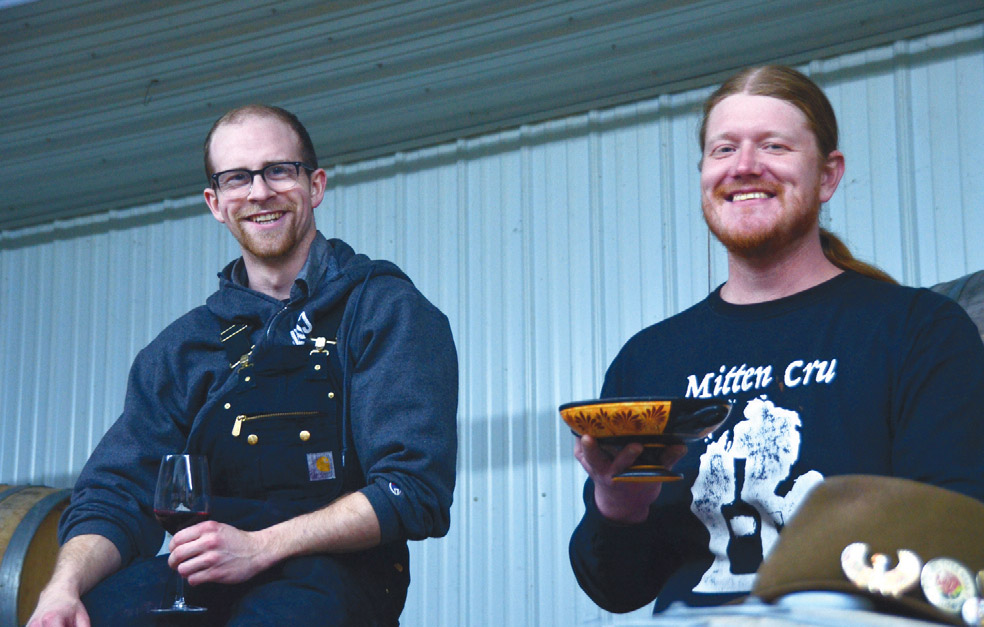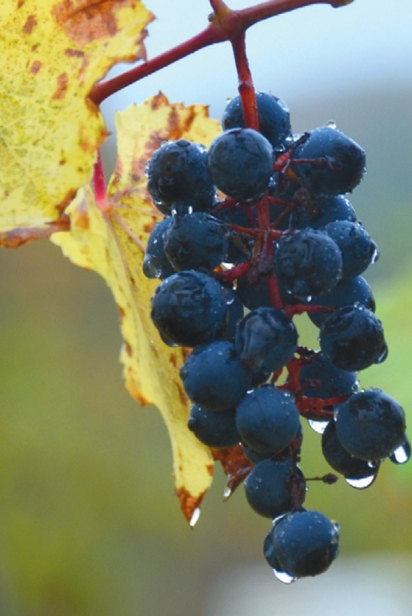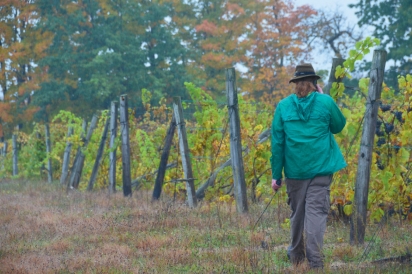Nathaniel Rose Wines
Wine ... that joy and prosperity may reign forever
Driving north on M-22 a couple miles out of Suttons Bay, rows of grapevines will appear on the west side of the road, followed shortly on the bay side by an old barn and a sign reading Nathaniel Rose Wines. Many who’ve traversed this beautiful lakeside route over the past 33 years know these vines, and hold memories of Raftshol Vineyards reds, first available through Old Mission Cellars, then Peninsula Cellars, and finally available on site from 1997 on.
It’s been a while since those vinifera blend reds have been available, and the vines that produced them have suffered neglect. But those times they are a-changin’ now.
Nathaniel Rose, 33, is a Michigan-grown vintner who, biochemistry degree from Western Michigan University in hand, learned his trade working for a number of Michigan wineries—in their fields, tasting rooms and cellars. Most recently he was winemaker at Brengman Brothers Crain Hill Vineyards south of Suttons Bay, where he established their winemaking program. Prior to that he had started the wine and mead program at St. Ambrose Cellars in Benzie County.
Rose has won numerous awards for his personal line of wines, including a double gold at the San Francisco Chronicle Wine Competition in 2017 for his 2013 Syrah Single Barrel Katherine’s Vineyard (sold out). He also won golds the same year for 2012 Abigail’s Vineyard Domaine Berrien Right Bank (available at the winery) and 2013 Abigail’s Vineyard Unfined Unfiltered Left Bank (to be released shortly), and Best of Class at the 2018 competition for his 2018 Pyment Leelanau Peninsula (a mead/wine blend currently available but selling quickly).
When asked why he chose to purchase the Raftshol winery and its vineyards, Rose explains that these are some of the oldest vinifera on Leelanau Peninsula, that he came to know these vines working alongside the former owner and vintner Warren Raftshol and that it’s always been his favorite winery in the region. It also fell within his price range.
But there is more. Rose has studied these vines, considered their close proximity to the bay (about 300 feet) and how this extends their growing season by providing a buffer from early frost. “It just doesn’t frost here. So it’s possible for reds. We bottomed out at a low of 39°F when nearby sites were hitting 27 and 25.”
And, he says, “Back in 1991, it was Stan [MSU Extension] Howell’s first test vineyard for inoculating mycorrhizal symbiotic fungus into the soil to live inside the cells of plant roots and form a network of hyphae that reach out into the soil, greatly increasing the effective root mass, enhancing defense against pathogens and increasing micronutrient uptake for the plants—just as our gut bacteria help us.”
However, the vines are now in need of care and attention before they can produce the quality grapes Rose believes they are capable of. To that end, he and his assistant, Ryley Gill, are working to prune, mow, re-wire and, where needed, replace vines, with an eye toward a 2020 harvest. It’s a long-term plan for someone who regards wine as a long-term game.
Rose makes wine in a traditional European style. Each wine begins in the choosing of the regions from which he sources his grapes (all Michigan). From his notes, “I carefully hand press the caps on ultra-small open-top fermentations on every cuvee, allowing me to shape the flavors of the wine using what the grape has to offer. All wines are carefully hand-loaded into a basket press to avoid the disruption from pumps. None of my red wines undergo fining or filtering. Instead, careful attention to the proper time in barrel and carefully repeated racking bring out the clarity and brilliance. Each wine goes through aging in bottle until it is ready to show. Only when the wine says it’s ready does hand bottling finally occur.”
And, most often, this translates to an average of four-and-a-half to five years before release.
As Rose describes his methods, it is clear that the timing of his winery purchase was carefully considered. “I put together a plan in 2010, putting down barrels for a wine project that would be over a half a decade away.” Though he’ll not be making and selling wine from his recently acquired vines for some time, he has wine to sell in his tasting room from 2012 and 2013 that is exactly as he’d like it to be, and more will come ready in the subsequent years; his wines from 2015, ’16 and ’17 are currently aging in barrels, enabling him to tend to his vines without the pressure to immediately produce from them.
2018, Rose’s first as a winery owner, was a year of trouble-shooting and, he says, “a harvest that both physically broke me and reinvigorated me at the same time.” Though he didn’t harvest from his own vines, he collaborated with the Rink family of Boskydel winery (closed on January 1, 2018) and took nearly all their harvest of hybrids. Having harvested their Frontenac, De Chaunac, Geneva Red, Noiret and other grapes in their field blend in 2017 for a black ice wine, and liking the results, Rose accepted the challenge this fall of taking in these different grapes, and will be making a range of wines with them, all with vineyard designation.
With a wide grin, he tells me this year’s harvest went as well as it could have. Though he was understaffed and had to pour a new crush pad to handle the quantity, he was able to harvest the Boskydel grapes at peak ripeness, mostly healthy, just before they would have fallen to the ground. The weather also cooperated in giving him 48 hours of cold sufficient to harvest and press the last of the grapes as ice wine.
Looking forward, “I want to see single-vineyard, world-class wine from the west coast of Michigan. In an ideal world I’d get a bunch of Syrah and ripe Viognier and do a Northern Rhône style Viognier/Syrah compilation, then do both Right and Left Bank Bordeaux blends from both Northern and Southern Michigan, explorations on the theme of Bordeaux.”
With a blend of starry-eyed contemplation and hard-earned experience, he says, “The virtue of Michigan is that we can make truly age-worthy, high-end reds and aged Rieslings. Our cooler climate is an advantage. Coastal Michigan doesn’t freeze ’til the middle of November. We have these long cool falls where fruit actually ripens. And we don’t lose the natural acidity due to the cool temps; the sugars don’t build to a level where we’d have 16–17 percent alcohol. We can get a truly ripe fruit that still has its chemistry in balance, similar to the Northern Rhône, Burgundy or Bordeaux.”
Elaborating, Rose speaks convincingly of the potential of Michigan’s west coast: “I don’t believe we do quick-release reds well. I understand the business imperative of getting wine on the market quickly, but the conditions here are perfect for long-aging, balanced reds. California has only a few tiny pockets where ageable reds can be made, and they charge top dollar for them, and have waiting lists of over five years. We have thousands of acres along the western coastline with the potential for subtle, longaging, elegant Bordeaux-style wines in the United States.”
Having sampled the 2012 and 2013 wines now available in his tasting room and noted the many awards on the walls, it is clear to me this young man is en route towards his North Star. Serious wine aficionados take note: If you are a fan of elegant, subtle European-style reds, carefully constructed and allowed to evolve before being released for sale, Nathaniel Rose is someone to discover and follow.
Nathaniel Rose Wines
1865 N. West Bay Shore Dr., Suttons Bay
231-271-5650 • NathanielRoseWine.com
Tasting notes by Christopher Kassel, Detroit-based journalist, author of Heart and Soil: Northern Michigan Wine Country and wine and spirits blog Intoxicology Report.
2012 Viognier Beautiful buttery honey in the nose, a touch of Botrytis in the mid-palate. Full-bodied, sharp with acid. A long, rich finish.
2013 Syrah la Blonde Coffee and dried herbs in nose, elevated red fruit in palate, light tannin in finish. Some lavish texture in the middle; all around a well-rounded cool climate Syrah.
2013 Pinot Noir Classic Pinot nose, with rose and ripe apple in the fore-palate, tart cherry and rhubarb pie carrying through to a quick but brilliant finish.
2012 Right Bank Finessed and fruity with chocolate-cherry up front, mulberry midway through and a nice sunny acidity that carries through to the conclusion.
2012 Left Bank An earthier, more savory version of Right Bank, this one carries with it darker cherry notes with black tea and a touch of black pepper. Strikingly complex on the palate with integrated tannins and acidity.







